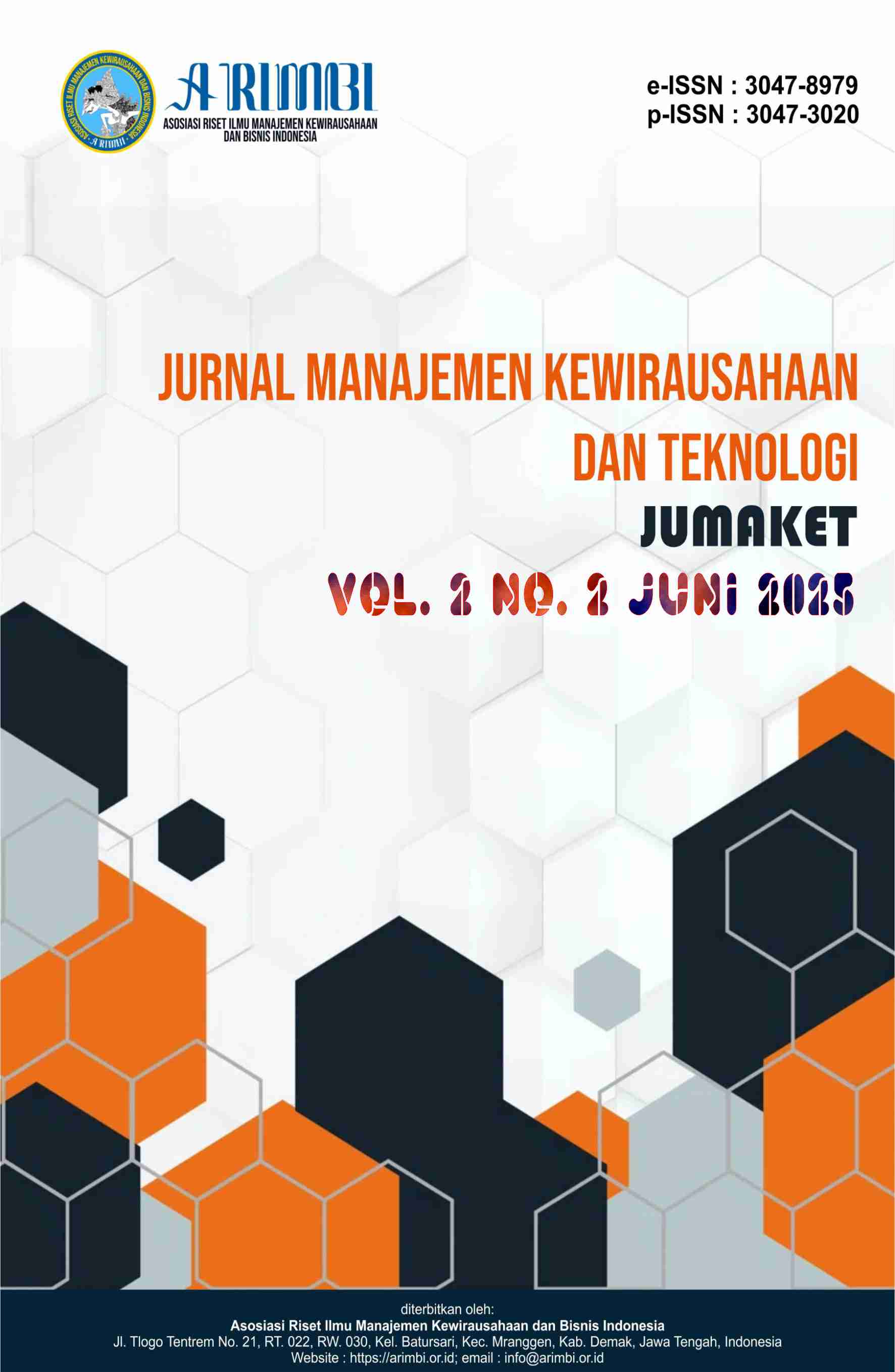Pengaruh Transformational Leadership, Communication dan Work Environment terhadap Kinerja Perangkat Desa melalui Job Satisfaction Sebagai Variabel Mediasi
DOI:
https://doi.org/10.61132/jumaket.v2i2.772Keywords:
Communication, Job Satisfaction, Transformational Leadership, Village Officials’ Performance, Work EnvironmentAbstract
Human resources play a fundamental role as a key component in supporting the success of an organization or agency, including village governments, as they serve as the link between formulated visions, missions, and targets and their actual implementation in the field. This study specifically focuses on examining the influence of transformational leadership, communication, and the work environment on the performance of village officials, with job satisfaction as a key mediating variable. The research method employed a quantitative approach with purposive sampling, involving 79 village officials deemed representative of the population. The findings indicate that transformational leadership partially has a significant impact on increasing the motivation, loyalty, and work ethic of village officials, as visionary leaders are able to direct, inspire, and encourage employees to work more optimally. Communication has also been shown to play a significant role, as open, two-way, and transparent communication minimizes misunderstandings and creates harmonious working relationships among employees and between superiors and subordinates. A conducive work environment, both physically, psychologically, and socially, contributes to a sense of security, comfort, and higher work morale. Furthermore, this study confirms that job satisfaction is a crucial mediating factor in linking transformational leadership, communication, and the work environment with the performance of village officials. This is because when employees are satisfied with their jobs, their commitment, productivity, and dedication to their tasks increase significantly. Therefore, this study emphasizes the need for an integrated strategy in human resource management at the village level, with an emphasis on an inspirational leadership style, an effective communication system, the creation of a healthy work environment, and increasing job satisfaction as a sustainable effort.
Downloads
References
Aditya, N. M. (2020). Dampak kompensasi, suasana kerja, dan tingkat kepuasan kerja terhadap performa pegawai pada RSUD Prambanan. Riset Informasi Kesehatan.
Afandi, P. (2018). Teori, konsep, dan ukuran dalam manajemen SDM. Zanafa Publishing.
Allen, N. J., & Meyer, J. P. (2016). Peran komitmen organisasi dalam meningkatkan kinerja karyawan Perusahaan Listrik Negara di wilayah Pekanbaru. Salemba Empat.
Amabile, T., & Pratt, M. (2016). An evolving framework of organizational creativity and innovation: Advancing understanding and impact.
Anshori, I., & Nurwulandari, R. (2021). Impact of leadership style, reward system, and workplace conditions on performance with job satisfaction as an intervening factor in PT. Sembilan Cahaya Abadi employees. International Journal of Social Service and Research, 1(1).
Aries, M., et al. (2017). Predicting employee discomfort from office design: The role of windows, views, and workspace characteristics. Journal of Environmental Psychology.
Baker, J., et al. (2021). Digital disruption in book retail: The role of the internet. Journal of Electronic Commerce.
Bakker, A. B., et al. (2014). The interplay between job burnout and engagement: A JD-R model examination. Journal of Organizational Behavior.
Bass, B. M., & Avolio, B. J. (2014). Enhancing organizational performance via transformational leadership. Sage Publications.
Bass, B. M., & Riggio, R. E. (2021). Leadership that transforms. Lawrence Erlbaum Associates.
Brown, M. E., & Treviño, L. K. (2015). Revisiting ethical leadership: Current insights and research agendas. The Leadership Quarterly.
Bryman, A., & Bell, E. (2015). Business research methods. Oxford University Press.
Burhan, M. (2022). Peran kepuasan kerja dalam memediasi hubungan antara komunikasi, disiplin, dan lingkungan kerja terhadap kinerja karyawan. Jurnal Disiplin Ilmu, 1(2). Universitas Katolik Widya Mandira Kupang. https://doi.org/10.55606/jupiman.v1i3.478
Diyanti, R., et al. (2021). Peran kepuasan kerja dalam menjembatani hubungan komunikasi dan komitmen organisasi terhadap performa pegawai di Bliss Barbershop Bali. Jurnal Ekonomi Bisnis, 2(2).
Donnelly, H., & O’Neill, S. (2016). Understanding integration through the Northern Ireland experience. Journal of Health Services Research & Policy.
Fernando, A., Bangun, R., Guci, D. A., & Indonesia, U. P. (2024). Kepuasan kerja sebagai mediator antara gaya kepemimpinan dan kinerja pegawai: Studi pada Kantor Desa Maileppet, Siberut Selatan. Mount Hope Management International Journal, 143–157.
Fisk, R., et al. (2014). Mapping the historical progress of academic work in services marketing. Journal of Retail Studies.
Floyd, M., et al. (2020). Sintesis temuan penelitian mengenai teori perlindungan motivasi. Jurnal Sosial dan Psikologi.
Ghozali, I. (2018). Strategi analisis multivariat melalui program IBM SPSS 23. Universitas Diponegoro.
Goetsch, D. L., & Davis, S. (2014). Dasar-dasar manajemen mutu total untuk efektivitas organisasi. Pearson Education Ltd.
Grawitch, M. J., et al. (2006). Towards a healthier workplace: A critical overview of workplace practices, employee wellness, and organizational growth. Consulting Psychology Journal: Practice and Research, 58(3), 129–147. https://doi.org/10.1037/1065-9293.58.3.129
Griffin, E. (2014). A first look at communication theory. McGraw-Hill.
Hadiyanto, A. (2017). Teori dan pengembangan: Iklim kelas dan iklim sekolah. Kencana.
Handayani, S. (2020). Metodologi penelitian sosial. Trussmedia Grafika.
Downloads
Published
How to Cite
Issue
Section
License
Copyright (c) 2025 Jurnal Manajemen Kewirausahaan dan Teknologi

This work is licensed under a Creative Commons Attribution-ShareAlike 4.0 International License.





